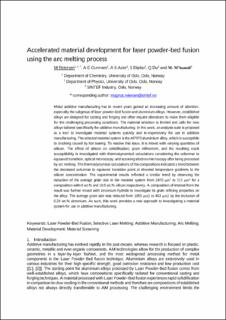| dc.contributor.author | Reiersen, Magnus | |
| dc.contributor.author | Gunnæs, Anette Eleonora | |
| dc.contributor.author | S. Azar, Amin | |
| dc.contributor.author | Diplas, Spyridon | |
| dc.contributor.author | Du, Qiang | |
| dc.contributor.author | M'Hamdi, Mohammed | |
| dc.date.accessioned | 2023-04-21T12:19:23Z | |
| dc.date.available | 2023-04-21T12:19:23Z | |
| dc.date.created | 2022-11-28T09:39:12Z | |
| dc.date.issued | 2023 | |
| dc.identifier.citation | IOP Conference Series: Materials Science and Engineering. 2023, 1274, 012014. | en_US |
| dc.identifier.issn | 1757-8981 | |
| dc.identifier.uri | https://hdl.handle.net/11250/3064277 | |
| dc.description.abstract | Metal additive manufacturing has in recent years gained an increasing amount of attention, especially the subgroup of laser powder-bed fusion and aluminium alloys. However, established alloys are designed for casting and forging and often require alterations to make them eligible for the challenging processing conditions. The material selection is limited and calls for new alloys tailored specifically for additive manufacturing. In this work, an analysis suite is proposed as a tool to investigate material systems quickly and in-expensively for use in additive manufacturing. The selected material system is the Al7075 aluminium alloy, which is susceptible to cracking caused by hot tearing. To resolve this issue, it is mixed with varying quantities of silicon. The effect of silicon on solidification, grain refinement, and the resulting crack susceptibility is investigated with thermodynamical calculations considering the columnar to equiaxed transition, optical microscopy, and scanning electron microscopy after being processed by arc melting. The thermodynamical calculations of the compositions indicated a trend between the decreased columnar to equiaxed transition point at elevated temperature gradients to the silicon concentration. The experimental results reflected a similar trend by observing the reduction of the average grain size in the material system from 2470 μm2 to 323 μm2 for a composition with 0 wt.% and 10.5 wt.% silicon respectively. A composition of interest from the result was further mixed with zirconium hydride to investigate its grain refining properties on the alloy. The average grain size was reduced from 1055 μm2 to 453 μm2 by the inclusion of 0.24 wt.% zirconium. As such, this work provides a new approach to investigating a material system for use in additive manufacturing. | en_US |
| dc.language.iso | eng | en_US |
| dc.publisher | IOP Press | en_US |
| dc.rights | Navngivelse 4.0 Internasjonal | * |
| dc.rights.uri | http://creativecommons.org/licenses/by/4.0/deed.no | * |
| dc.title | Accelerated material development for laser powder-bed fusion using the arc melting process | en_US |
| dc.title.alternative | Accelerated material development for laser powder-bed fusion using the arc melting process | en_US |
| dc.type | Peer reviewed | en_US |
| dc.type | Journal article | en_US |
| dc.description.version | acceptedVersion | en_US |
| dc.rights.holder | © 2023 The Author(s) | en_US |
| dc.source.volume | 1274 | en_US |
| dc.source.journal | IOP Conference Series: Materials Science and Engineering | en_US |
| dc.identifier.doi | 10.1088/1757-899X/1274/1/012014 | |
| dc.identifier.cristin | 2082098 | |
| dc.relation.project | Norges forskningsråd: 309584 | en_US |
| dc.relation.project | Norges forskningsråd: 323335 | en_US |
| dc.source.articlenumber | 012014 | en_US |
| cristin.ispublished | false | |
| cristin.fulltext | postprint | |
| cristin.qualitycode | 1 | |

